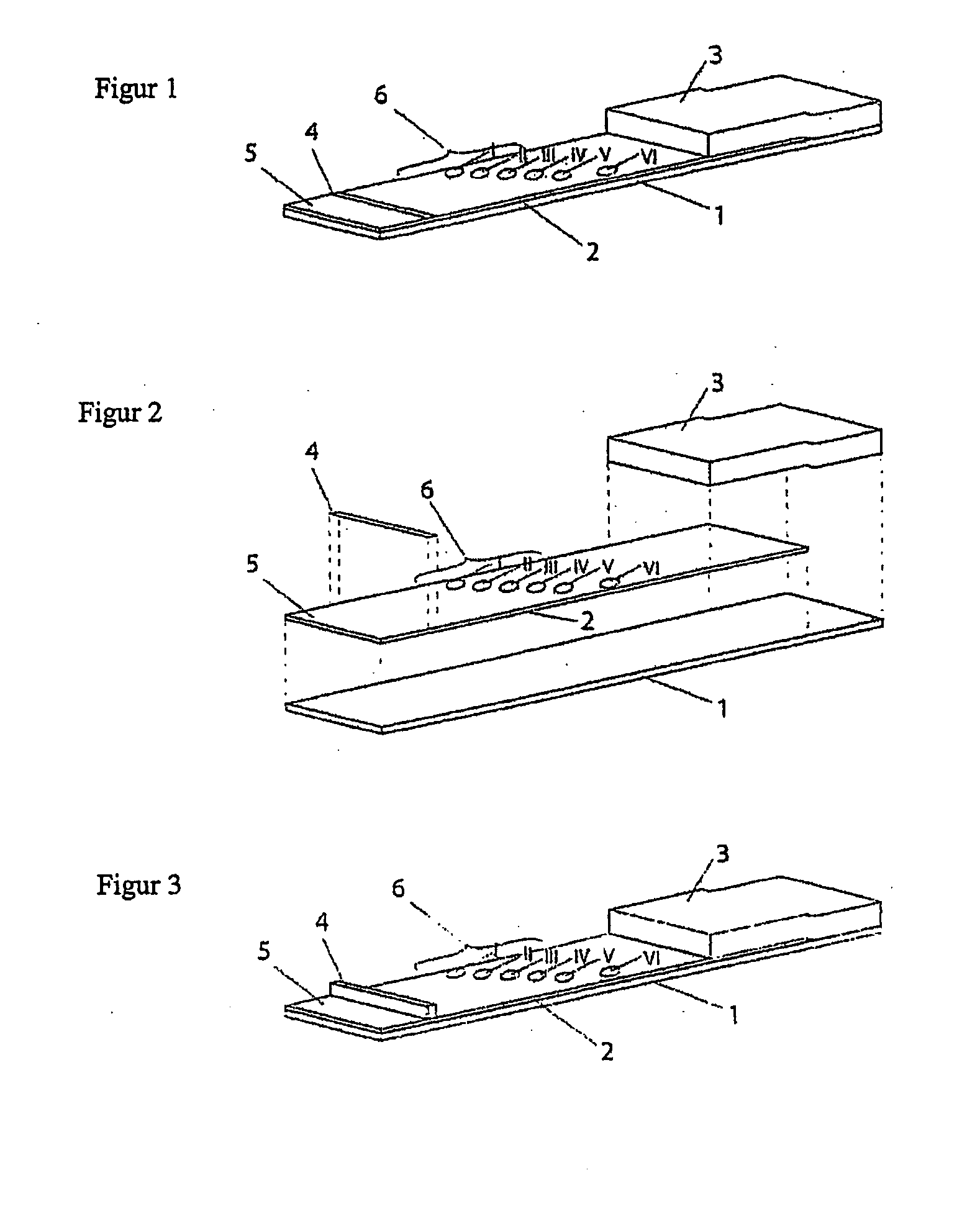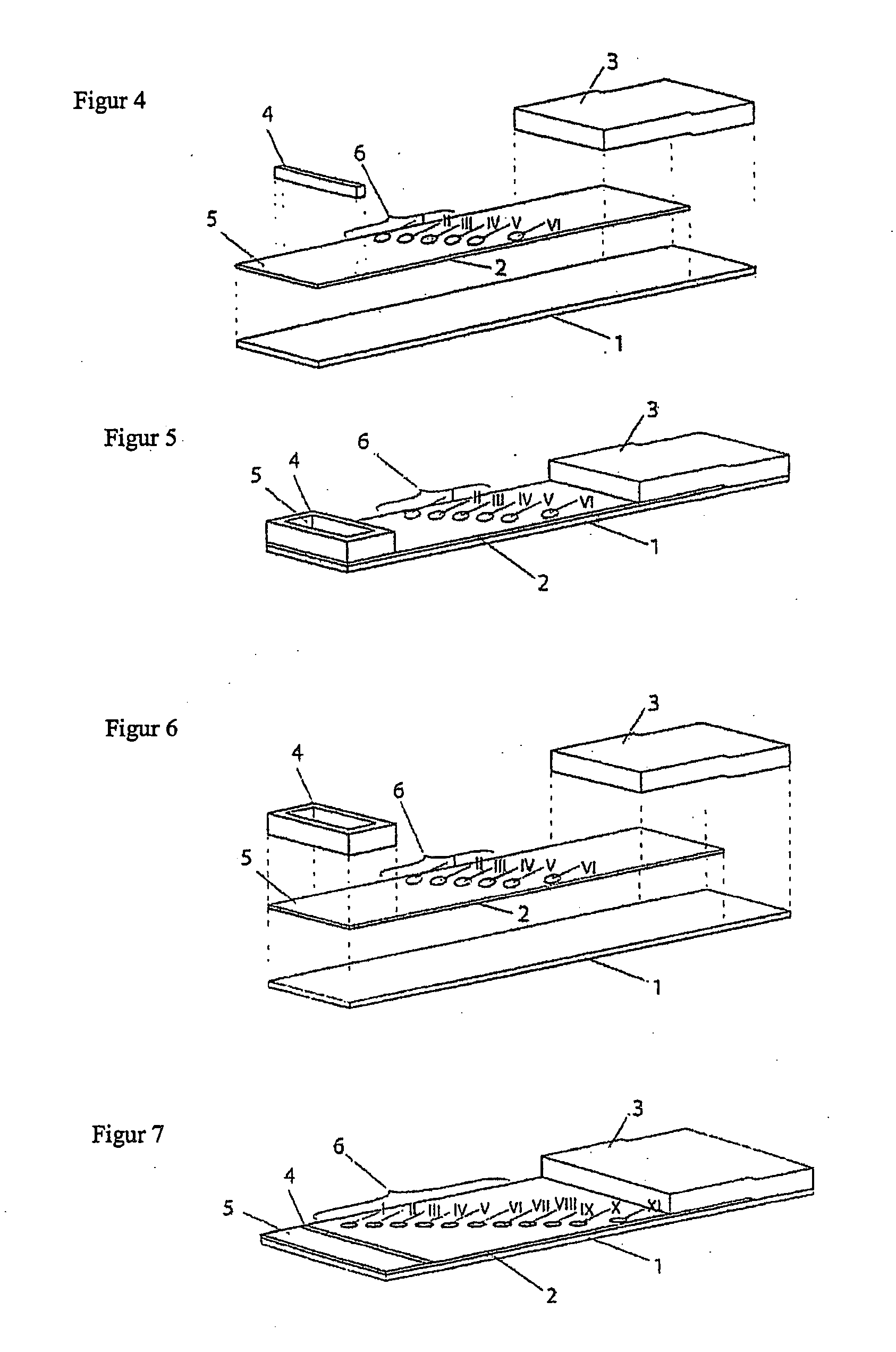Device and Method for Simultaneously Identifying Blood Group Antigens
- Summary
- Abstract
- Description
- Claims
- Application Information
AI Technical Summary
Benefits of technology
Problems solved by technology
Method used
Image
Examples
example 1
Blood Group Determinations
[0079] Production of Test Strips:
[0080] The test strips comprise an application zone, an indicator zone region and an absorption region. Membranes of the type Millipore HiFlow Plus 065 are cut to size in strips, sized 15 by 35 mm (width / length; x / y) for a six spot embodiment or respectively sized 26 by 40 mm for an 11 spot embodiment and adhesively fixed onto a support layer (backing sheet e.g. of G&L). Diagonally or alternatively staggered in a linear row 0.2 μl dots of solutions of various blood groups specific monoclonal antibodies are applied in the indicator zone region using a dispenser, e.g. AD3200 (Biodot):
[0081] Anti-A clone Birma-1 (Serologicals, TLJ0105); anti-B clone ES-4 (Serologicals, NCA0201); anti-AB clones AB6, AB26, AB92 (Medion Diagnostics, 010062); anti-D clone LDM3 (SNBTS, Z7180100); anti-C clone MS-24 (Serologicals, unformulated, KGK0212; Anti-c clone MS-33 (Serologicals, KNI0207); anti-E clones MS-80+MS-258 (Serologicals, KXE0201);...
example 2
Bedside Test
[0089] Production of Test Strip:
[0090] The bedside test comprises two membranes each (“blood preserve”, “recipient”) fixed onto a support layer (backing sheet), each comprising an application zone, an indicator zone region and an absorption region.
[0091] Membranes of the type Millipore HiFlow Plus 065 are cut to size in strips of a size 12.5×30 mm (width / length); x / y). Two each thereof are adhesively bonded onto a support layer (backing sheet e.g. of G&L) spaced apart by 5 mm so that the overall assembly has a size of 30×30 mm.
[0092] Using a dispenser, e.g. AD3200 (Biodot) the following identical applications are applied, staggered diagonally onto each of the two membranes: 0.2 μl dots of solutions of the monoclonal antibody anti-A clone Birma-1 (Serologicals, TLJ0105) in position x=4 / y=12 mm; anti-B-clone ES-4 (Serologicals, NCA0201) in position x=7 / y=14 mm. The anti-erythrocyte specific control antibody (rabbit IgG fraction of anti-human RBC, Rockland, 209-4139) is...
example 3
Blood Group Determination with Bi-Directional Lateral Flow Test
[0101] Production of the Test Strips:
[0102] The test strips comprise an application zone in the central region of the membrane, two indicator zone regions and two absorption regions. Membranes of the type Millipore HiFlow Plus 065 are cut to size in dimensions of 15×50 mm (width / length, x / y) and adhesively bonded onto a support layer (backing sheet e.g. G&L). Diagonally staggered or alternatively in a linear row staggered 0.2 μl dots of solutions of different blood group specific monoclonal antibodies are applied in the indicator zone region. The central region of the test strip (y=0 mm) serves as the reference dimension for the positioning of the indicator zones in the y direction. The following antibodies are dispensed using a dispenser, e.g. AD3200 (Biodot):
[0103] Anti-a-clone Birma-1 (Serologicals, TLJ0105); anti-B-clone ES-4 (Serologicals, NCA0201); anti-AB-clones AB6, AB26, AB92 (Medion Diagnostics, 010062); ant...
PUM
 Login to View More
Login to View More Abstract
Description
Claims
Application Information
 Login to View More
Login to View More - R&D
- Intellectual Property
- Life Sciences
- Materials
- Tech Scout
- Unparalleled Data Quality
- Higher Quality Content
- 60% Fewer Hallucinations
Browse by: Latest US Patents, China's latest patents, Technical Efficacy Thesaurus, Application Domain, Technology Topic, Popular Technical Reports.
© 2025 PatSnap. All rights reserved.Legal|Privacy policy|Modern Slavery Act Transparency Statement|Sitemap|About US| Contact US: help@patsnap.com



